
Most hardy fruit plants
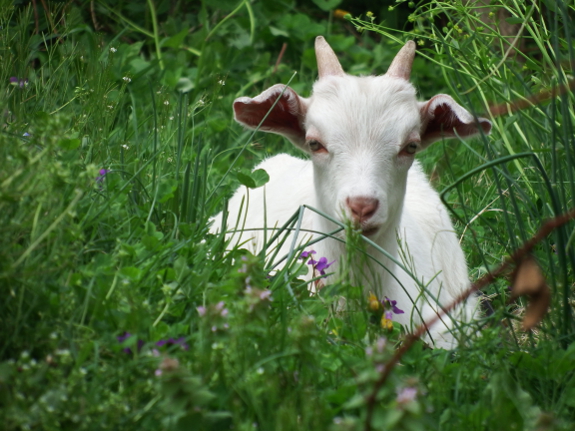
I'm going to talk about a
lot of dead plants in this post, so here's a cute shot of Lamb Chop as
preemptive mitigation. Feel free to scroll back up here if you start to
get depressed.
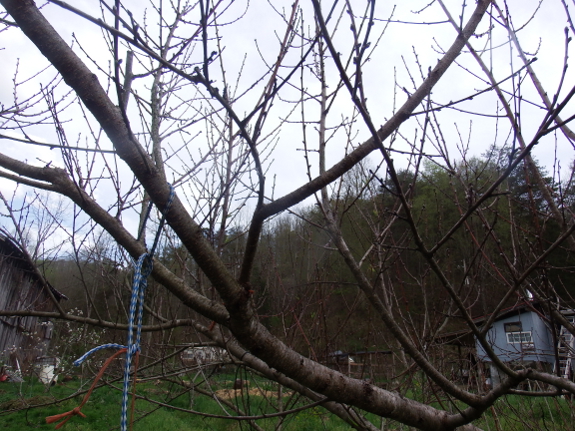
I used to think that late spring freezes
were the primary bane of fruit-growers in our region, but this past
winter taught me otherwise. With a low of -22 Fahrenheit, which is more
typical of zone 4 than zone 6, all of our peach trees not only lost
their bloom buds midwinter...they also lost most of their branches. Each
tree has a couple of dozen leaves finally coming out of winter-bare
limbs, and once I'm confident that all living buds have sprouted, I'll
prune the trees way back to start their lives nearly over. At last, I'm
beginning to understand why so few people in our region try to grow
peach trees --- the stone fruits aren't really reliably hardy here in
the mountains, despite being supposedly able to handle weather up
through zone 5.
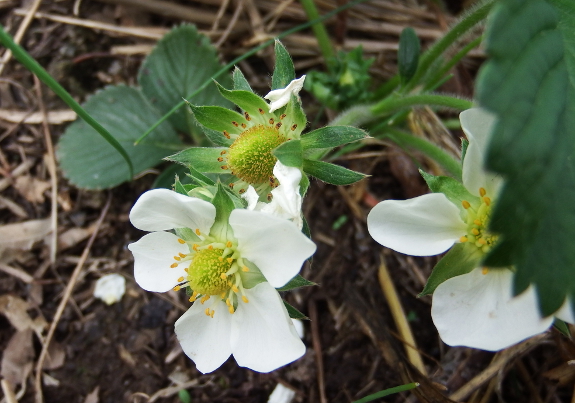
Similarly, this is the
second or third winter when nearly all of our blackberries have been
killed back to the ground, and a few of our black raspberries were
similarly affected for the first time this year as well. Once again,
blackberries and black raspberries are only hardy to zone 5, while red
raspberries and strawberries (both of which came through this winter
unscathed) are hardy to zone 3. Climate change seems to be reliably
introducing an element of unreliable extremes to our winters, so I think
it's safe to say that we're better off focusing on fruits like plums
and red raspberries that can handle bouts of extreme cold rather than
depending on species that are turning out to be undependable in our
region. (Good thing red raspberries and strawberries are Mark's and my
favorite berries, respectively.)
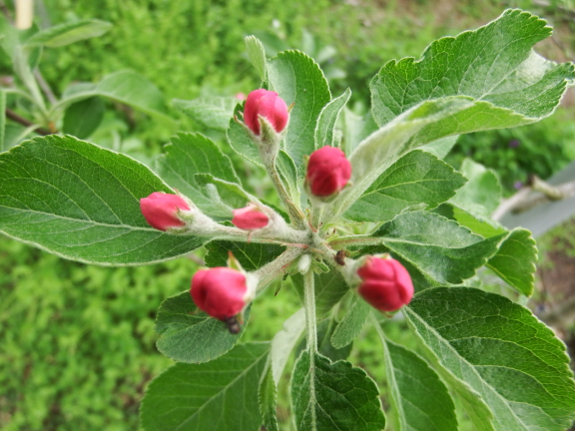
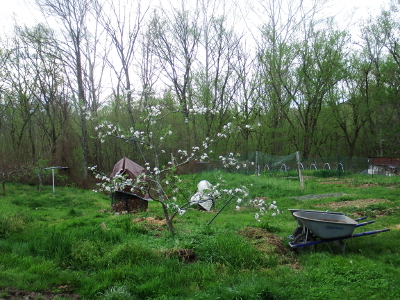 I
can't be sure, but I feel like even some of our apple bloom buds were
affected by the winter's extreme cold, even though the species is
supposed to be hardy to zone 3. The tree that gets more winter sun is
loaded with flowers, but the high-density planting closer to our
north-facing hillside has opened far fewer flowers than the number of
bloom buds this winter seemed to suggest.
I
can't be sure, but I feel like even some of our apple bloom buds were
affected by the winter's extreme cold, even though the species is
supposed to be hardy to zone 3. The tree that gets more winter sun is
loaded with flowers, but the high-density planting closer to our
north-facing hillside has opened far fewer flowers than the number of
bloom buds this winter seemed to suggest.
As a result, I'm
putting more thought into protected locations that are likely to
mitigate winter's extreme cold when I plan ahead for locating our newly
grafted fruit trees. 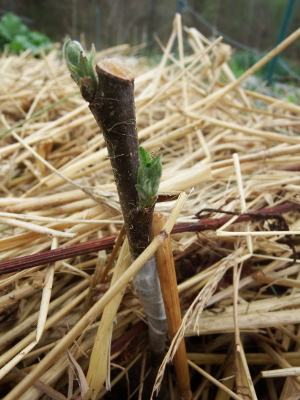 Currently,
I'm eying the south-facing side of the gully which, if terraced just
above the waterlog-line, would provide a warm and protected environment
for quite a few tender fruit trees. Maybe that's where I'll plant our
new plums?
Currently,
I'm eying the south-facing side of the gully which, if terraced just
above the waterlog-line, would provide a warm and protected environment
for quite a few tender fruit trees. Maybe that's where I'll plant our
new plums?
In more pleasant news,
leaves are starting to appear on the scionwood of many of my newly
grafted fruit trees. I'm pretty sure that when these buds burst, that
means the cambial layers of the scionwood and rootstock have merged
(i.e. the graft has taken). So far, 14 out of 16 apples, 8 out of 10
pears, and 1 out of 5 plums have begun to unfurl leaves on the
scionwood. Since the pears and plums were only grafted a little over a week ago,
I have high hopes that the success percentages of the latter two
species will rise to match the apples in time. So it looks like I'll
have plenty of experimental material to replace what we lost last winter
--- I'll have to use my new trees wisely!
Want more in-depth information? Browse through our books.
Or explore more posts by date or by subject.
About us: Anna Hess and Mark Hamilton spent over a decade living self-sufficiently in the mountains of Virginia before moving north to start over from scratch in the foothills of Ohio. They've experimented with permaculture, no-till gardening, trailersteading, home-based microbusinesses and much more, writing about their adventures in both blogs and books.
Want to be notified when new comments are posted on this page? Click on the RSS button after you add a comment to subscribe to the comment feed, or simply check the box beside "email replies to me" while writing your comment.

I've lost so many plants over the last few years. The trees that are already well established are doing fine, the blueberries are so-so, so I bought more. The strawberries, which I had in containers, pretty much are dead as Daleks. All of my crape myrtles seem to be dead. I've given up on crape myrtles despite the fact that I love them. Even the well established ones seem to have died.
On the plus side, the lilacs, which I planted despite a friend saying they don't do well here, seem to be thriving as well as a couple of flowering quinces which actually had flowers on them this year! The wild blackberries are coming back like crazy. I hate them. They're invasive and have the nastiest tasting "fruit" you can image. It takes like gravel or grit. I'd love to have raspberries but I'm terrified they'll cross-pollinate with the wild blackberries (which are growing EVERYWHERE and which I spend an inordinate amount of time cutting down) and end up with raspberries that taste like sand or very fine gravel.
Glad to see your scionwood is working. I've never had any luck with that.
Say, Anna, we're in Northwest Missouri (zone 5b) and our blackberries produced well even after the freakish winter of 2013 when we dipped into the negatives several times. Our plants were transplanted from a native thicket nearby, which also produced well despite the bitter cold. Do you think this is a different variety than any that you've tried? And would you be interested in me sending you some to try out in your area?